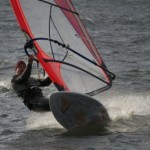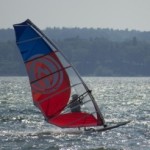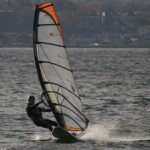Home Page › Discussion Forum › General Windsports Discussion › Wide Skis and Foiling are hurting your knees!
- This topic has 5 replies, 3 voices, and was last updated 4 years, 7 months ago by
 Geoff.
Geoff.
-
AuthorPosts
-
-
September 3, 2019 at 12:38 pm #7578
 ScottParticipant
ScottParticipantThis article minus some great graphics is about wide skis and your knees, in short how the upright stance adopted by the wide skiing technique hurts your knees. I think there is a parallel here regarding windsurf foiling based on my limited experience and knee pain I’ve experienced. So enjoy the read and maybe Dr. Geoff will chime in on this thoughts? PS I couldn’t figure how to link this so I’ve just copied it from the REALSKIERS.com page.
Why Wide Skis Aren’t Good for Your Knees
In his introduction to an overview of current research on the effects of wide skis, Prof. John Seifert of Montana State University explains two fundamental ways that wide skis expose the knee to injury. (We’ll get into the mysteries of just how wide is “wide” and other variables in a minute.) The first of the Big Fundamentals is that wide skis force skiers to adopt a more upright stance. Less bend at the knee means the muscles that support the joint are no longer in their optimal position to exert force. This means the knee is more vulnerable just when the second Big Fundamental, Ground Reaction Force, is at its peak in the apex of a turn.
That’s a lot of information to unpack. Citing a study of knee kinematics by Slovenian colleagues, Prof. Seifert shows data that strongly suggests that skiers on wider skis adopt a more upright stance in order to alleviate strain, and in doing so lose muscular strength just when it’s needed the most. Furthermore, from this posture the femur doesn’t internally rotate to the same degree as the tibia, contributing directly to knee strain. It’s the inability of the tibia and femur to rotate in concert that can cause soreness in the joint to develop in less than a day of skiing.
The taller stance induced by wide skis reduces the amount of force the skier can generate in the muscles that help protect the knee.
Ground Reaction Force is a major contributor to knee vulnerability on wide skis that also causes skiers to change how they navigate downhill. Prof. Seifert explains, “I would define ground reaction force as the force exerted by the snow in contact with it. GRF is always present, even in deep snow, as it’s part of what makes a ski turn. GRF is influenced by skiing velocity and turn radius. On hard snow with wide skis, this is why drifting is so common or the turn radius is lengthened in order to minimize forces.”
How Ground Reaction Force induces stress on the knee.
Here’s the kicker: depending on snow density and water content, it takes 8 to 14 inches of snow to reduce the negative effects GRF. When you’re romping around on 6 to 8 inches, GRF is with you all the way. The wider the ski, the more GRF is multiplied and the greater the strain on knee ligaments when trying to get the ski on edge.
Whether by instinctive reaction or conscious decision, a skier with a wide ski on hard snow defuses GRF simply by not edging. Drifting along on the heavily rockered baseline limits directional change to foot swiveling with relatively little loading in the belly of the turn (where pressure would build on a narrow ski on hard snow). While being in a constant power drift helps reduce knee strain to some degree, it also entails an inherent loss of control.
This isn’t a supposition or a theory. The physics of GRF isn’t imaginary. The study of knee kinematics isn’t based on guesswork. There will always be a certain amount of fuzziness to the data because test conditions are so difficult to control; researchers don’t get any more powder days than you do. But the trend in the data is factual and irrefutable. Wide skis on hard snow are a bad idea, period.
Prof. Seifert opens his remarks by enumerating all the unquantified variables that make research in the field so challenging. When it comes to skis and knees, perhaps the most basic question is, how wide is too wide?
In the absence of standard definitions, Prof. Seifert settles on 90mm underfoot and up as wide, 80-90mm as mid-width and 80mm and below as narrow. With all the other variables that can contribute to a change in outcomes – snow surface conditions, skier age, gender, mass and ability, to name a few – this is perhaps as precise a definition as we need.
While I have absolutely no data to support my suspicions, my theory is that a ski’s width is essentially invisible to the skier’s knee as long as the ski is no wider than the skier’s tibia head, or the point of ligament attachment. When advising skiers on ski width, my homemade metric is most men can ski up to a 100mm-wide ski without feeling routine strain when edged, while for women this guideline is 90mm. My thoughts on the subject can be seen in this brief video.
One reason no one knows exactly how wide is too wide is that research in this field requires money, perseverance and patience to test any proposition about ski-skier interaction. Money for this purpose doesn’t drop from the sky. When Prof. Seifert sought funding from the National Institute of Health, his request was denied on the grounds that skiing was an elitist sport. Ouch.
If any of my Fellow Elitists would like to contribute to Prof. Seifert’s work on injury dynamics, please send your charitable donation to: The Rocky Mountain Consortium for Sports Research.
I hope that many of you will view Prof. Seifert’s lecture, but for those of you who don’t, here’s the distillate:
Physics doesn’t lie. All the supporting numbers from various research projects may not be a complete match, but they come very close.
The best protection against injury is good ski technique.
Knee injuries are positional in nature. The tall stance induced by wide skis takes the muscles supporting the knee out of their ideal length-tension angle.
The strain required to overcome Ground Reaction Force on hard snow causes skiers instinctively to drift instead of edge, thereby losing a measure of control.
If you don’t already possess strong technical skills, a wider ski will hinder your skills development.
To increase your chances of passing your PSIA Level III exam, use a narrow ski.
To mitigate the risk associated with their use, wide skis need to be in powder around a foot deep. Even if you find fresh snow this deep, how long does it last? Once powder turns into crud, GRF raises its intensity.
Thanks to research like that conducted by Prof. Seifert, the pied pipers of fat skis can no longer pretend that wide skis are just as good on hard snow as they are in powder. More research is needed, and thankfully there are four new studies looking into leg extension on wide skis. New work is also being done to illuminate the perils of mixing AT boot soles with Alpine bindings and to better define the limits of tech binding performance in resort conditions. I hope those of you, my Dear Readers, who are able will contribute to Prof. Seifert’s work by donating here. -
September 4, 2019 at 7:44 pm #7582
 GeoffGuest
GeoffGuestWell, I think this article is what you get when someone without any technical knowledge tries to interpret biomechanical research. His video is a little better, but the article is terrible IHMO. He clearly doesn’t really understand ground reaction forces and moment arms (aka lever arms), though he’s absolutely right that wide skis that are great in powder are not good on hard pack.
Wide skis / snowboards are like your sailboard, they “plane” on the fluid (snow) that they’re in. Like your sailboard, they “carve” through powder by using the normal force (perpendicular to the bottom of the ski/board) to move you through an arc. Because it’s angled, and not pointing straight up against gravity, the snow/water is pushing in the direction of the center of your turn. So you turn. There is some flexing of the ski/board that assists, and the fin of a sailboard is also pulling up on the tail, adding to the turning force.
On hard snow, it’s more like a flexible ice skate, where the edge of the ski digs in, and the sidecut (curvature of the side of the ski) and the flexing of the ski make the edge form an arc. By digging into the snow, the arc forces you to turn. Bigger sidecuts (wide shovel/tail with narrow at the feet) are easier to turn because they have a smaller radius of curvature.
Put a big wide ski, made for powder, on hard snow, and if you’re going to carve the turn, you’ll have to lever the ski up onto the edge. And the author’s point is that this takes a huge amount of strength to do and hold, because the edge has more leverage on your foot. One must counter that leverage with force, muscular strength to hold the ski up on it’s edge. Very few people are strong enough to do that, so instead of carving the turn, they have to skid the turn.
I guess if wide skis are all you have, it’s better than not skiing. But skidding your turns isn’t good skiing, and the increased leverage of the ski on you does make it more likely to hurt something (mainly ligaments). The article seems kind-of out of sorts, though, in that I think the proper conclusion (which he says in the video) is to have the right kind of ski that matches the conditions you’re skiing in. About the same as boards fins and sails!
I have not comment on whether or not foiling is bad for knees, because I don’t know what Scott’s ideas are. Two things that do greatly concern me about foiling are: 1) forefoot fracture dislocations, and 2) foil lacerations. A Lis-franc injury is a very bad day and will keep you out for many months, and lacerations can be disfiguring and lethal. A foil has an immense amount of leverage (i.e. moment arm), which is why at slow speeds it can hold you and your board and rig up in the air. If that were unintentionally focused onto your foot/ankle, you are not going to come out well. And pain is not always temporary, which is why we have an opioid epidemic. I seriously doubt that I would use footstraps on a foiling board, but would ride one more like an WindSUP. Then again, take a look at Balz Muller foilstyling (links below).
Lis-franc’s:
Laceration:
https://www.theinertia.com/surf/heres-what-happens-when-a-foil-board-hits-you-in-the-face/
Foilstyling
https://www.youtube.com/watch?v=LNfnI5PWVzU
-
September 5, 2019 at 9:46 am #7583
 ScottParticipant
ScottParticipantGeoff, I was trying to get this post past the admin., should have elaborated more about the parallel I though I saw in this article about wide skis hurting your knees. In short, the more upright stance wide skis skiers often adopt and the upright stance I often find myself using on foil make the knee less able to withstand some the loads placed on it. As I understand it a flexed knee is better supported by the muscles and ligaments surrounding it. My layman’s interpretation of the situation! Then again maybe I’m just getting old, cause everything hurts! lol
PS good advice on fin, I was looking at an MFC Liquid Pro similar to sweep fin you mentioned.
-
September 5, 2019 at 9:18 pm #7590
 GeoffGuest
GeoffGuestMy price is better!
-
-
September 5, 2019 at 4:18 pm #7588
 windydougKeymaster
windydougKeymasterInformative read and opinions you guys. I’m in the market for some new skis and this helps inform my decision with sore knees in mind.
Wd
-
September 5, 2019 at 9:27 pm #7591
 GeoffGuest
GeoffGuestGet the right skis for the snow.
Scott’s problem COULD be due to localized arthritic degeneration of knee / kneecap cartilage. Can’t say more with what I know, no exam, no imaging of the knees in question.
As an aside, I would say that I’ve seen (and have done some research to show) that non-articular sources of pain are significant in a lot of people. In non-medicalese…soft tissues (ligaments, bursas, muscul0-tendinous junctions, etc.) cause a LOT of pain in a LOT of people, most of whom don’t have clinically significant joint destruction (i.e., loss of the shiny, rubbery, slippery cartilage on the ends of the bones). In general, I would bet on that problem first, and articular problems next. But figuring that out requires a good sports medicine or ortho doctor.
Your low-value American health care system, which provides the worst $/benefit value on Earth, is woefully inadequate at A) diagnosing this problem, or B) helping you make it less bothersome.
GEM
-
-
-
AuthorPosts
- You must be logged in to reply to this topic.
